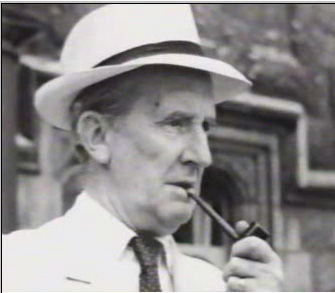| "The language
of Beowulf is in fact partly 're-paganized' by the author with a
special purpose, rather than christianized (by him or later) without
consistent purpose. . . . There is a gap, important and effective
poetically whatever was its length in time between Caedmon and the poet of
Beowulf. We have thus in Old English not only the old heroic
language often strained or misused in application to Christian legend . .
., but in Beowulf language of Christian tone occasionally (if
actually seldom) put inadvertently in the mouth of a character conceived
as heathen. All is not perfect to the last detail in Beowulf"--Appendix
sec. b
I. The problem with much Beowulf
scholarship of the period is that it is more focused on the poem as a
cultural artifact than as an actual poem.
A. Tolkien provides an allegorical sketch of the
history of this scholarship up to 1936.
B. By treating it primarily as a product of
history, critics praise and blame the poem for something other than what
it was intended to do.
C. Tolkien provides a second allegory of a house,
a tower, and the sea, which he uses to critique the historically-minded
critics.
D. He examines typical criticism of this sort by
Ker, Chambers, and Girvan, which tends to find Beowulf lacking
something in plot, in believability, or in epic construction.
II. Tolkien, in turn, defends the poem.
A. It is a work highly polished and
possessing a unity of style and tone with its themes.
B. Comparative folklore studies are especially apt
to mistake antiquarian allusion for literary criticism.
III. Myth is "incarnated" by a poet "in
the world of
history and geography."
A. Beowulf is a poem that relies on mythic
power, for example, the slaying of the dragon. [Note the aside,
"More than one poem in recent years. . .", about Tolkien's I˙monna
Gold Galdre Bewunden and C.S. Lewis's "Once the
worm-laid egg broke in the wood"--both poems on dragons.]
B. Beowulf's dragon is almost a personification of
life's malice, but it is not an allegory.
C. The dragon episode is set within the
Anglo-Saxon heroic worldview and its tragedy.
D. The monsters in the poem are deeply tied to its
central aesthetic, one of death and the symbolism of evil.
IV. Tolkien argues that the poem is a fusion of the
old pagan Norse world and the new Christian one.
A. Thus, for example, this transformation helps
explain the material nature of Grendel and his mother, who are,
nonetheless, called demons.
B. It also explains how the old Norse view can be
retained to some extent by the Christian culture, regarding it as both
dark and remote yet still having an imaginative hold.
C. It leads to a double suppression within the
poem of aspects of both the old pagan gods and of Christian theology.
The poem does not present the worst of the former nor can it embody all
aspects of the later.
V. Likewise, the cultural shift is not complete--the
poem does not present a complete Christian worldview--the internal,
spiritual enemy within us defeated with an eternity of heaven waiting.
A. The tone of regret is still present, without
its accompanying despair.
B. Beowulf is a model of piety in a world of
"man fallen and not yet saved, disgraced but not dethroned."
VI. What distinguishes the poem from Southern myths
and epics is Northern tragedy.
A. Tolkien rejects any influence by The Aeneid
upon Beowulf, even while recognizing a kinship in tone.
B. The Northern monsters and the gods are more
humane, existing within the world of Time and its eventual end.
C. The Northern solution is courage and honor in
the face of eventual cosmic defeat.
VII. Tolkien conceives of the author of Beowulf
as a Christian poet looking back on a pagan time with appreciation for the
old heroism.
A. The poet conceptualizes its kings as noble
chiefs before the Christian faith arrives.
B. So, likewise, its pagan past is significant in
its idolatry and its nobility.
VIII. The poem's structure is one of achievement
(1-2199) and of death (2200-3182).
A. This is a static structure, not a plot that
advances so much as it balances life's opposites.
B. Tolkien recognizes that the long recapitulation
and the journey to another land work against this structure, but notes
that the poet was working with a story already in existence.
C. A second division in the poem happens after
line 1887, with the foreboding of disaster.
D. The poem is finally better judged as "an
heroic-elegiac poem" than an epic.
VIII. Conclusion: Tolkien offers an imaginary
contrast with the story of Saint Oswald and what would have to be done to
it to rise to Beowulf's thematic power. The poem, he finally
insists, is a late poem in its culture, dealing with its pagan past. |
